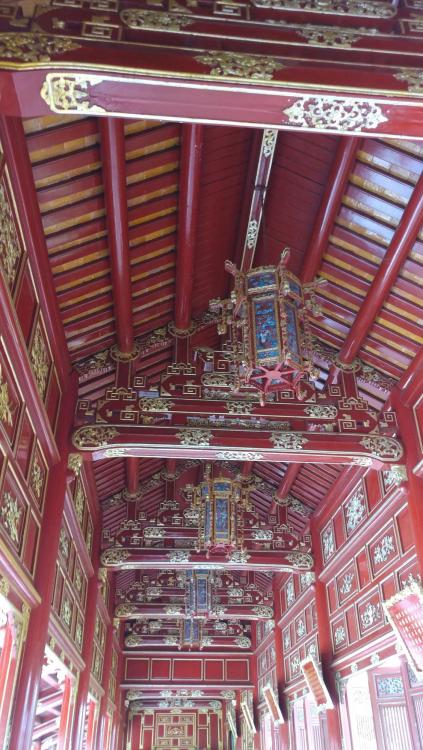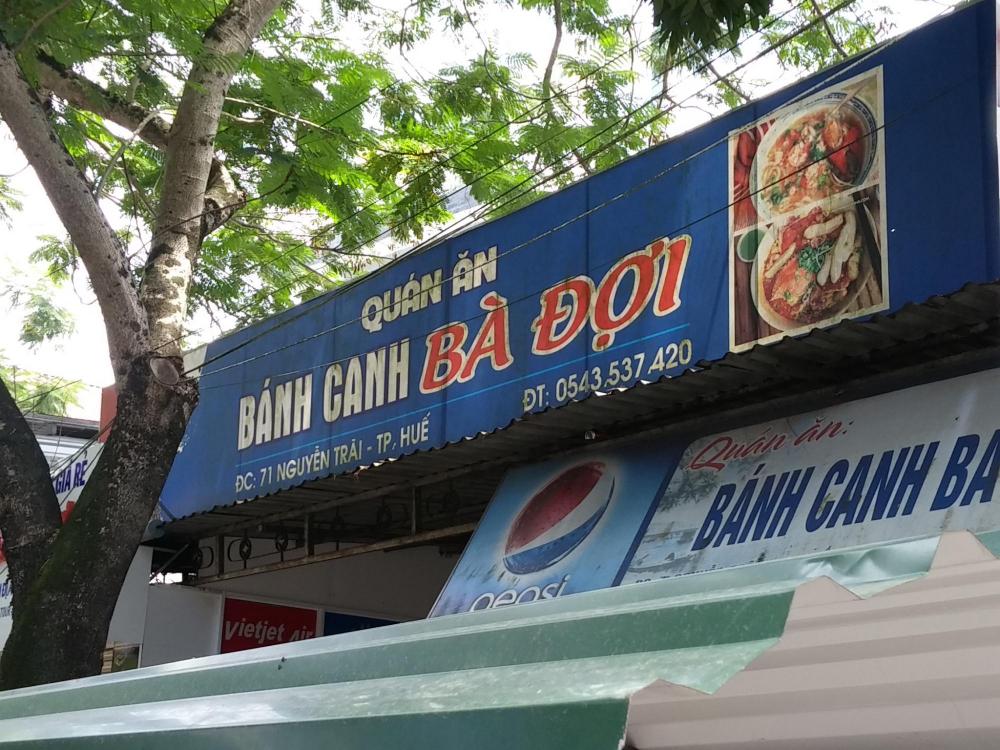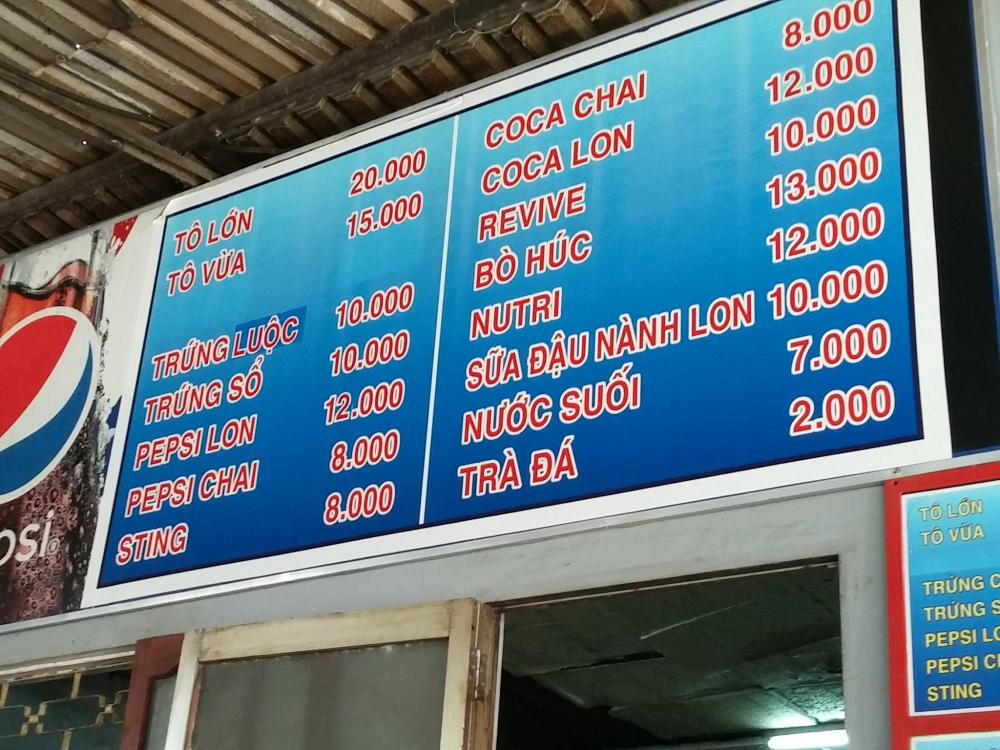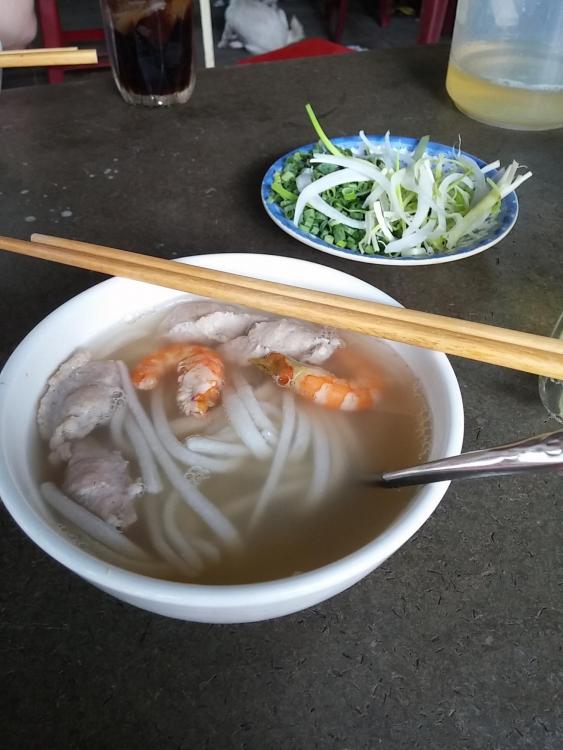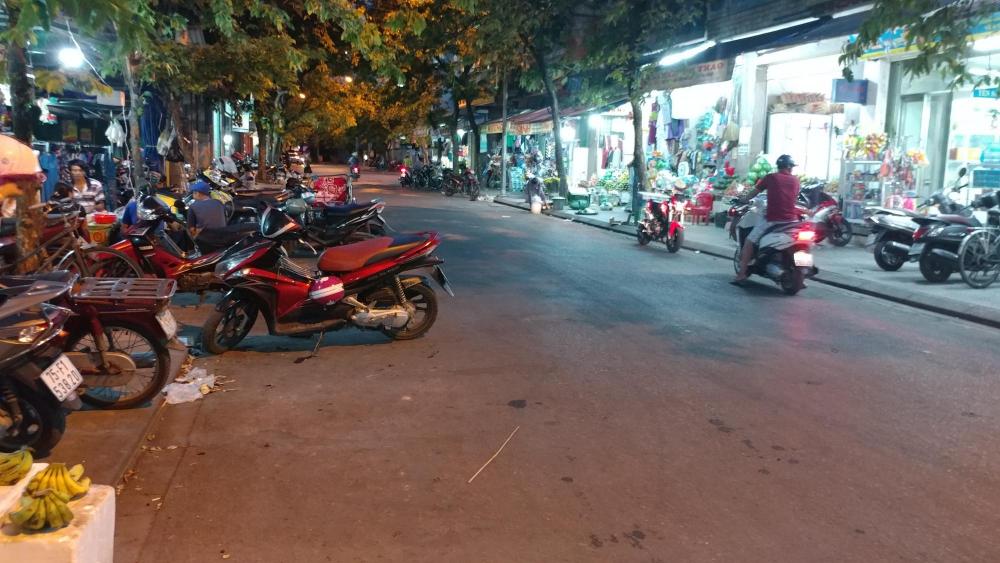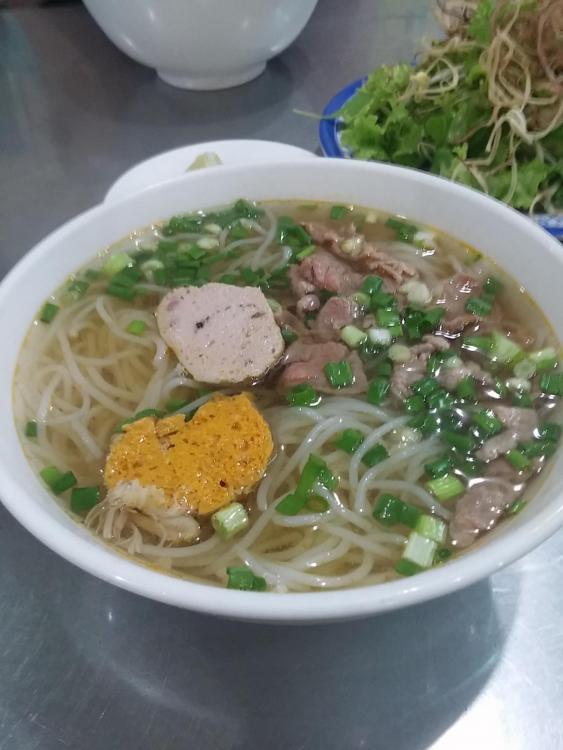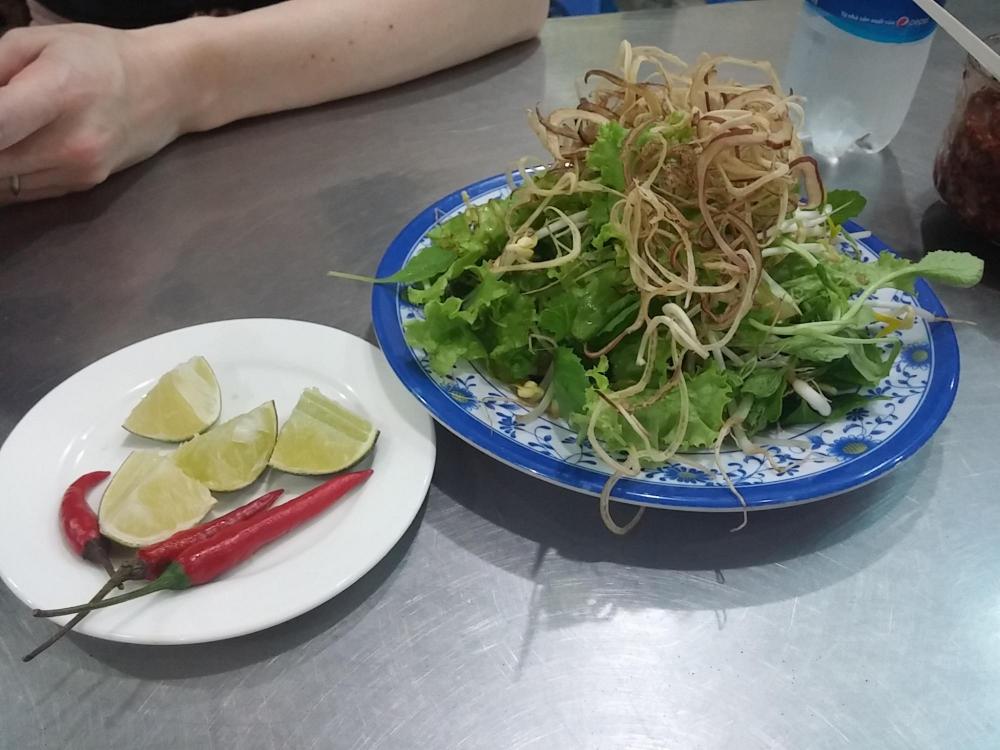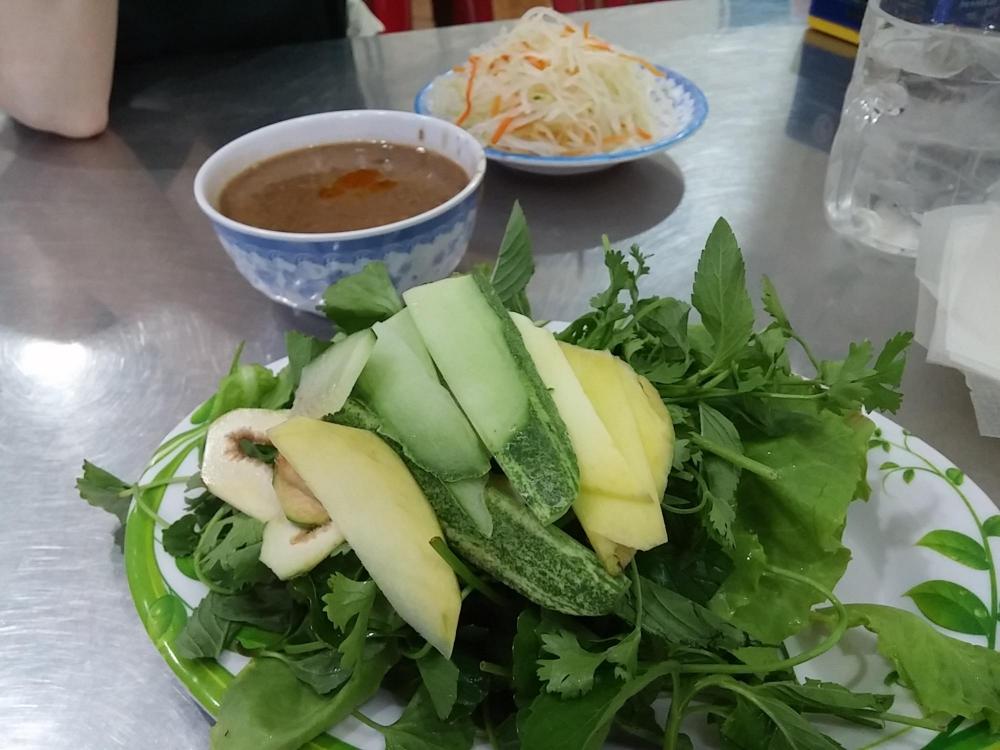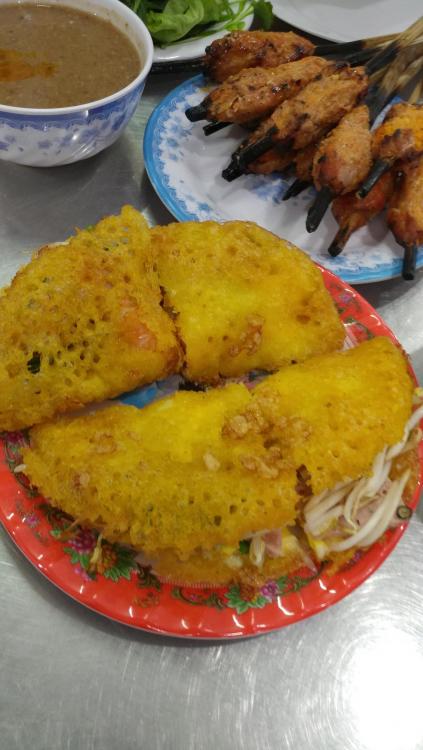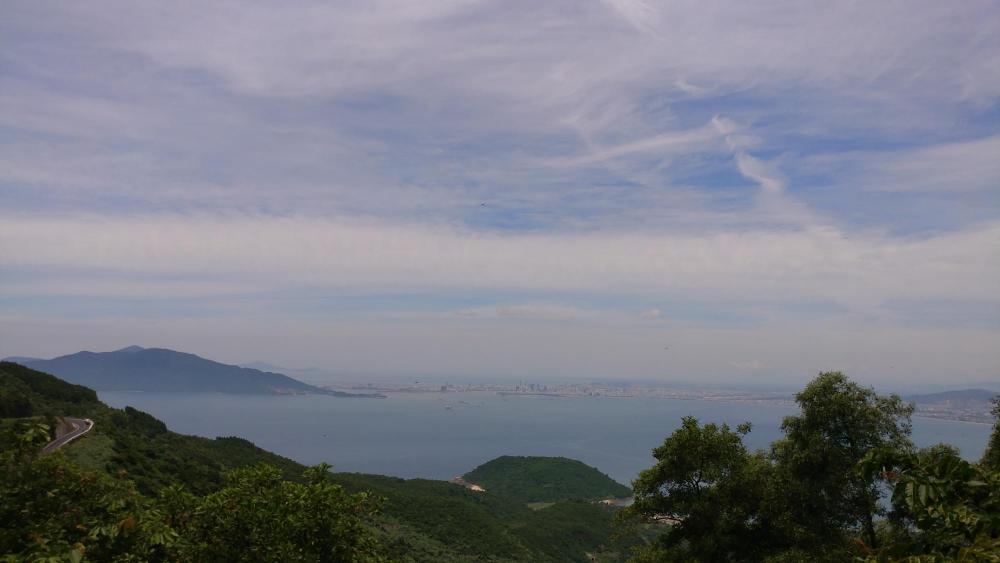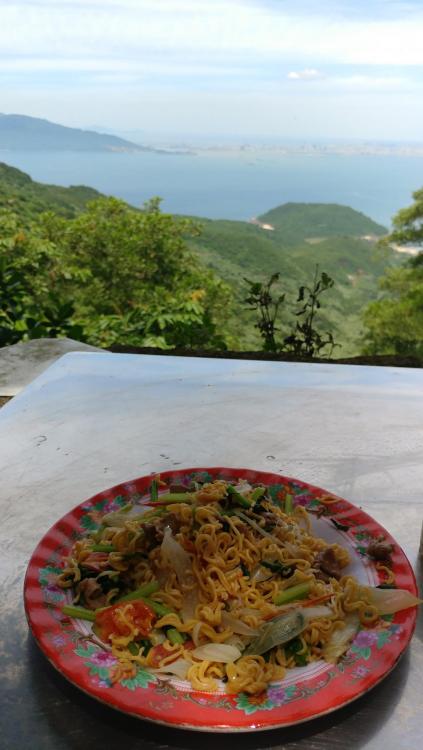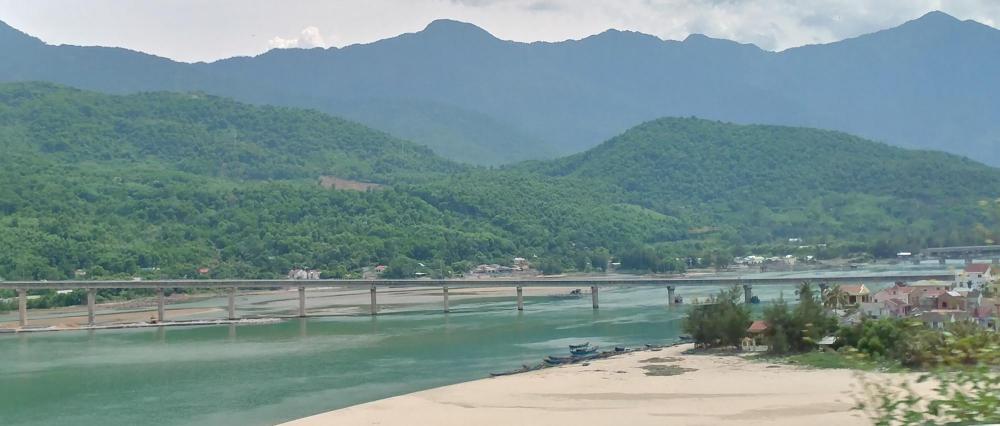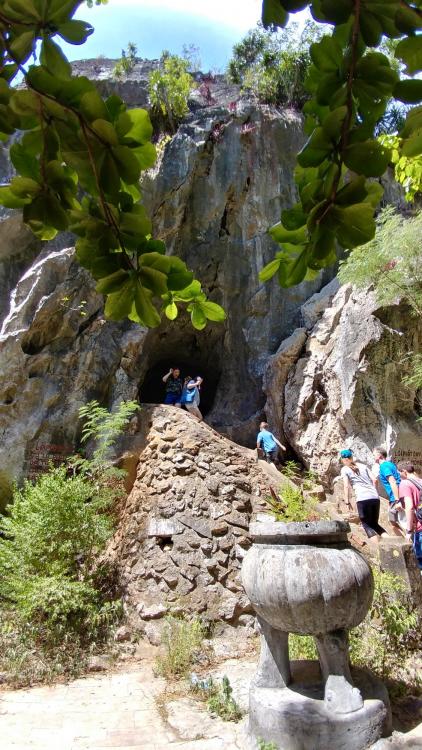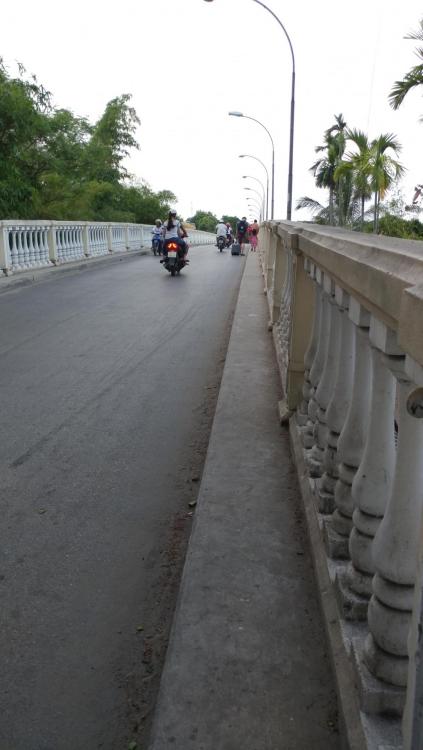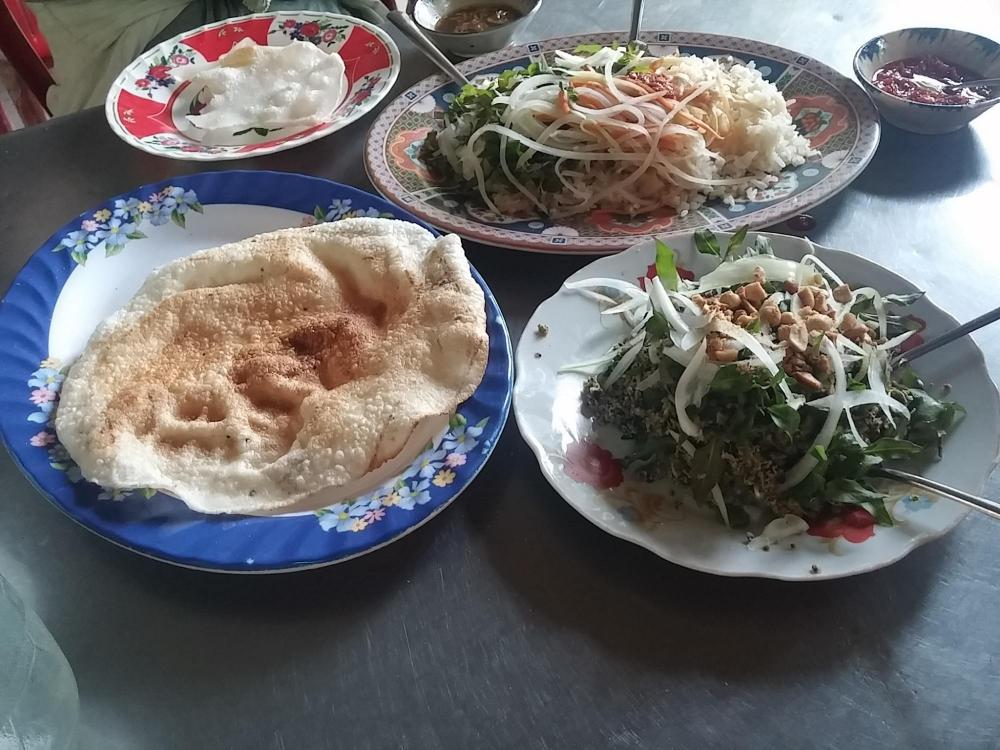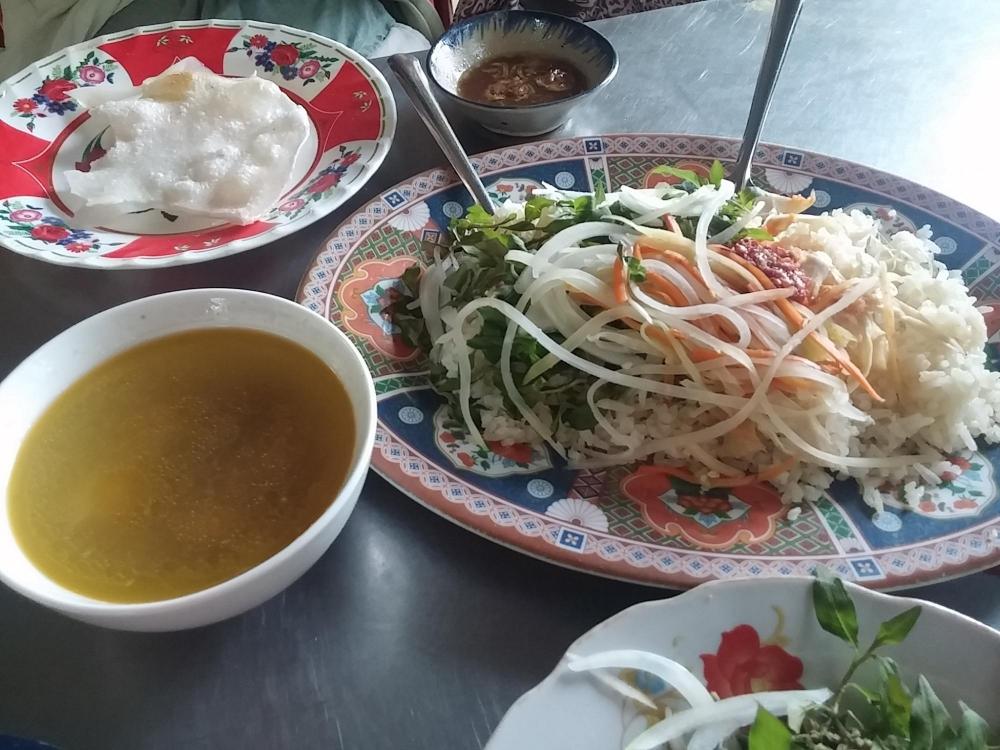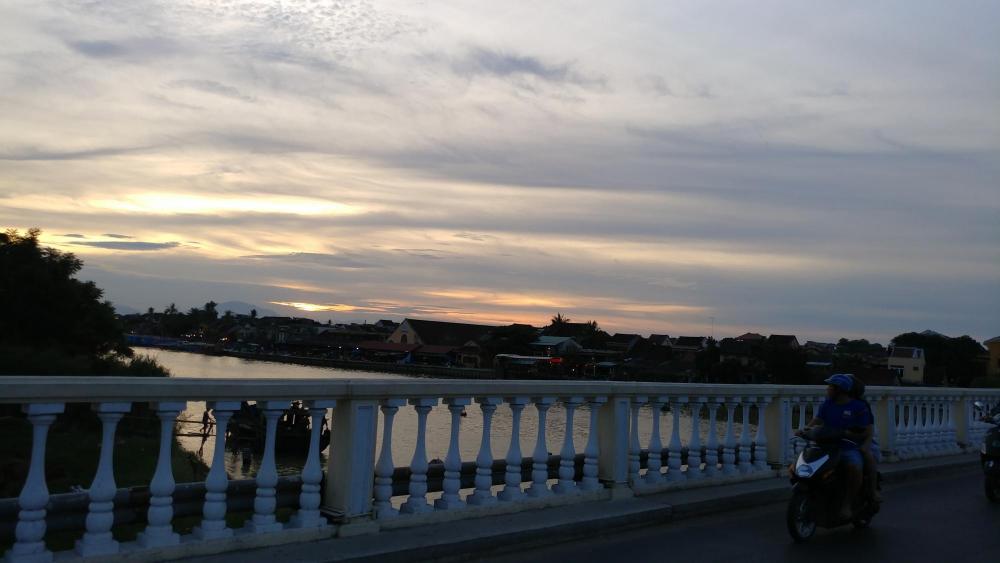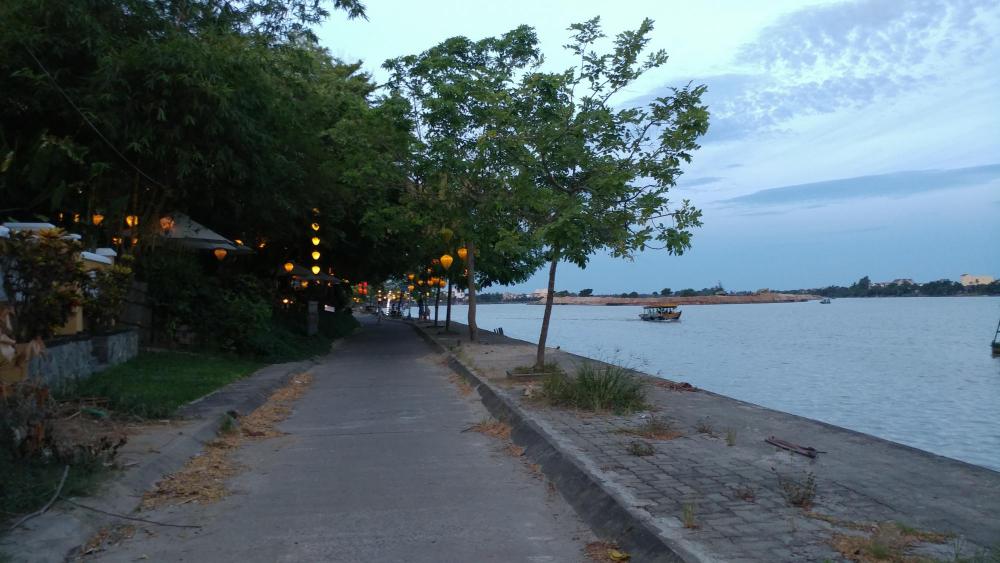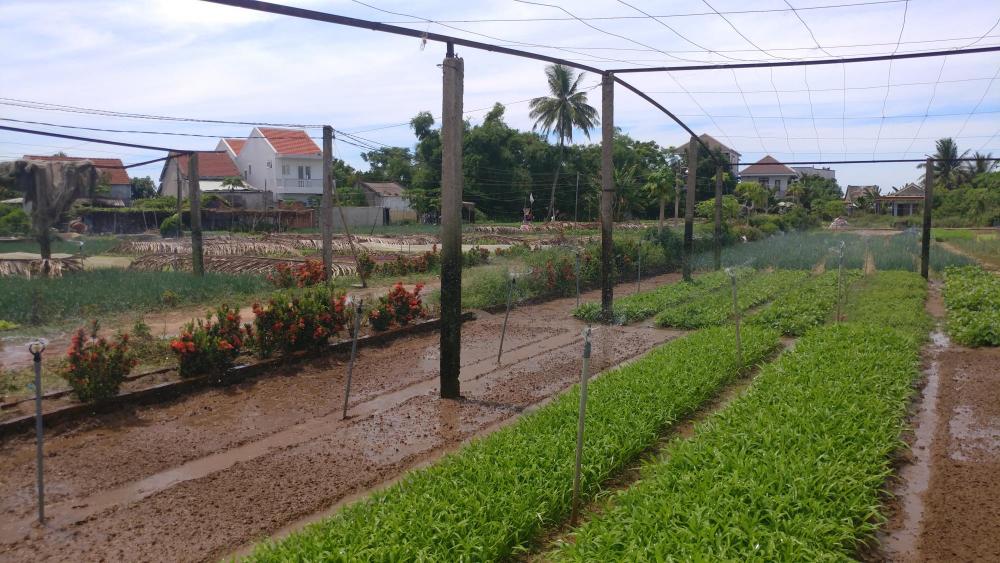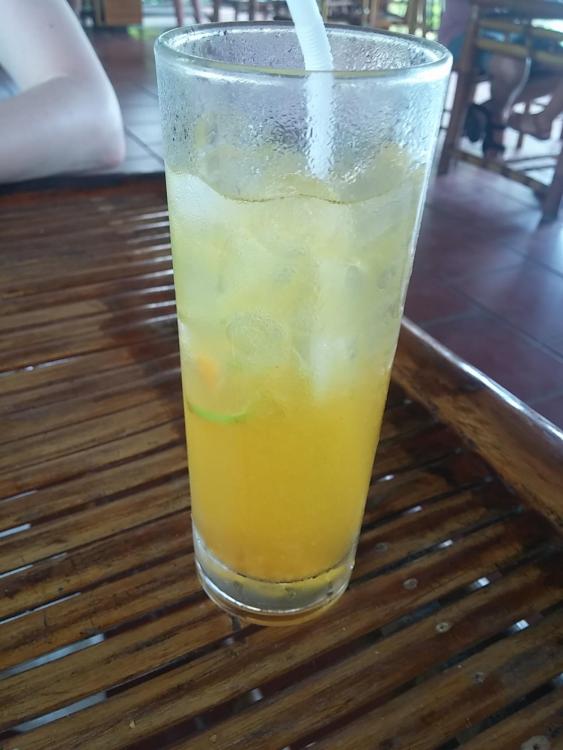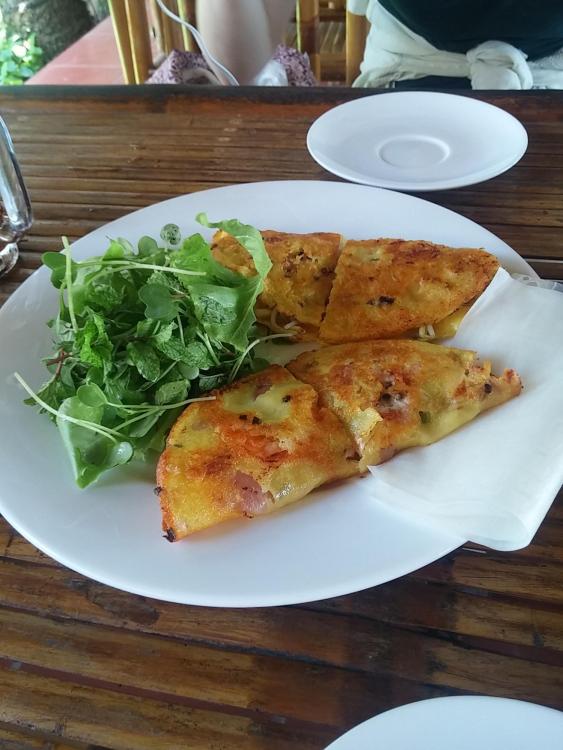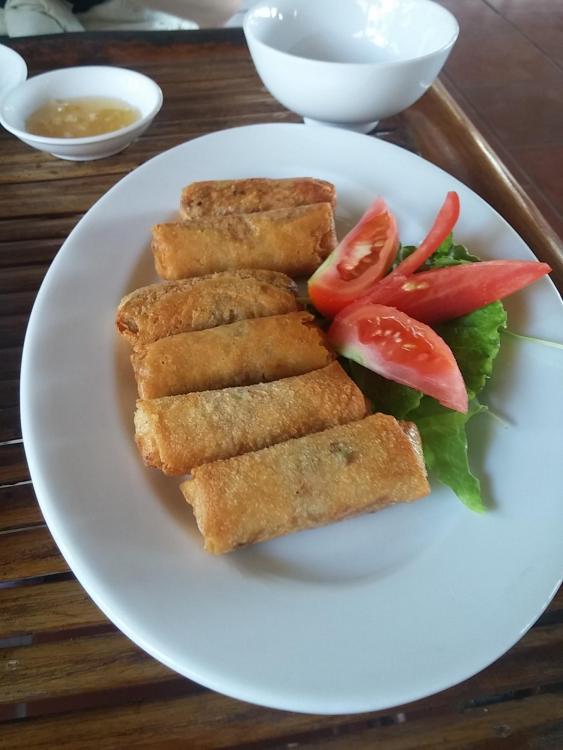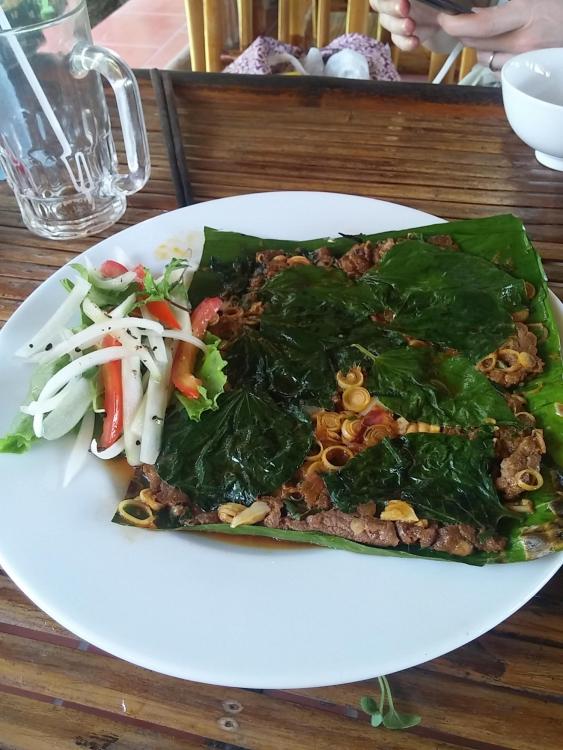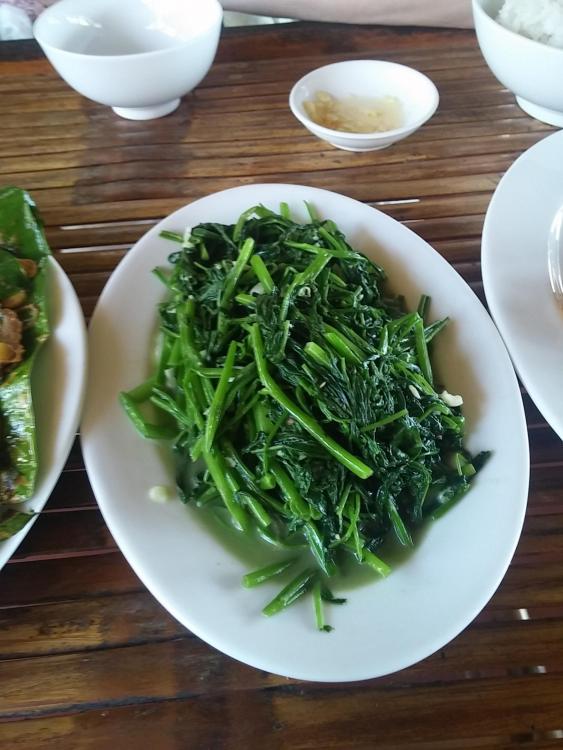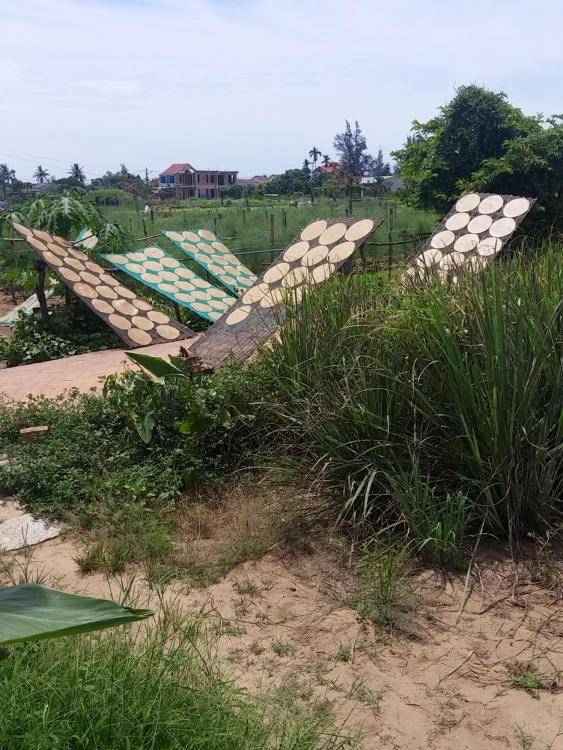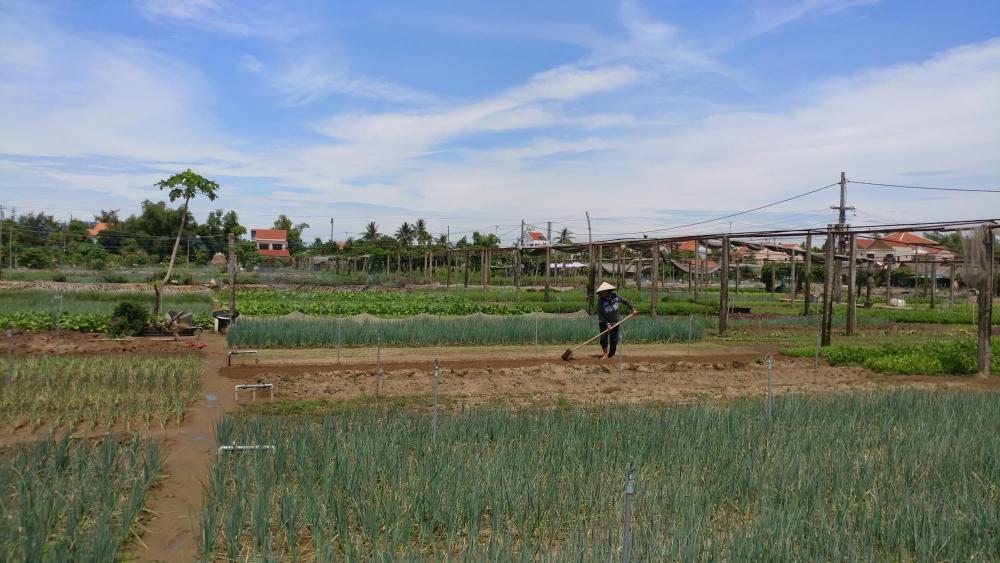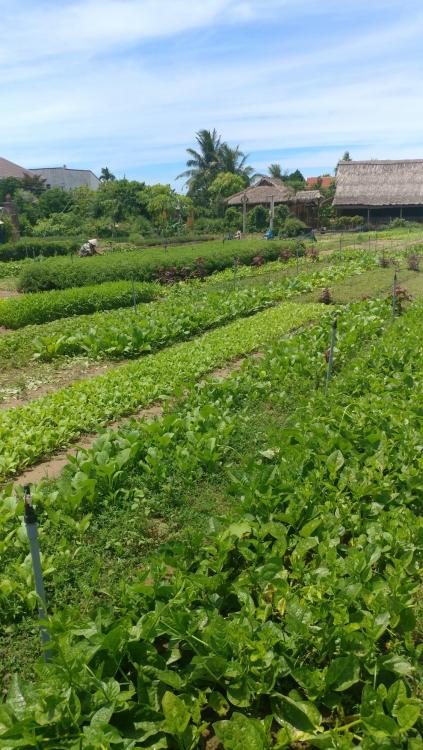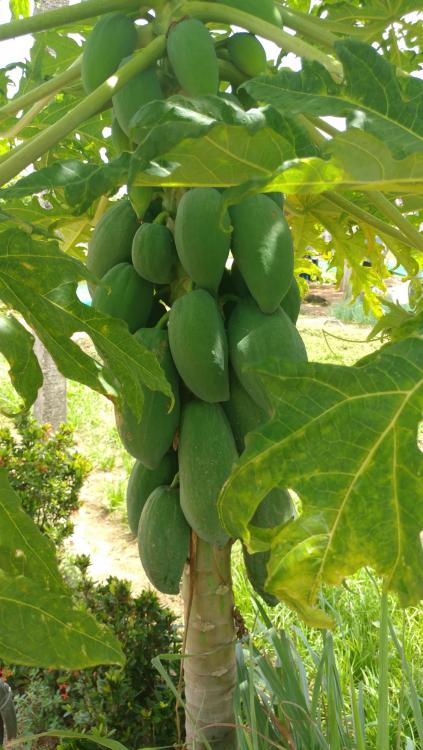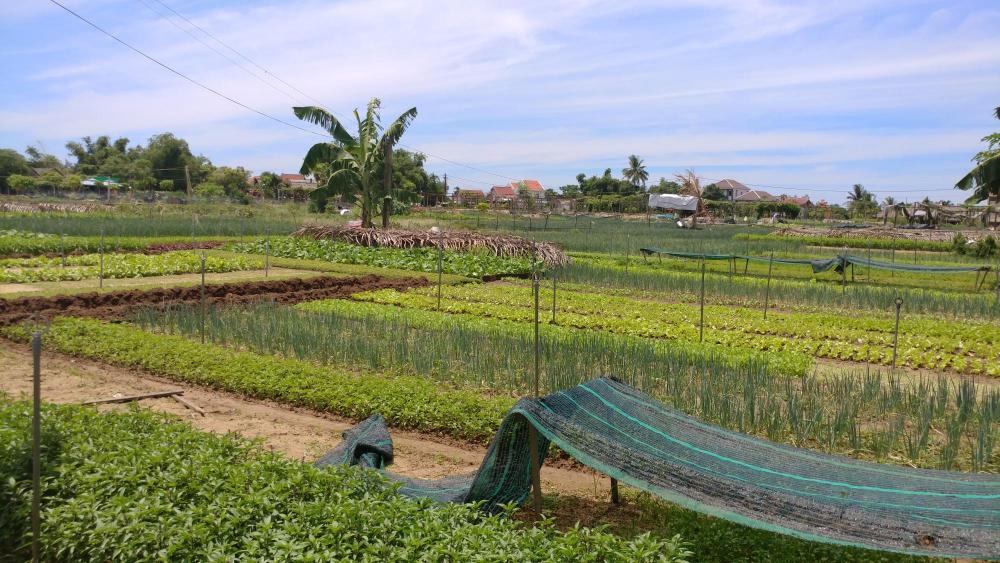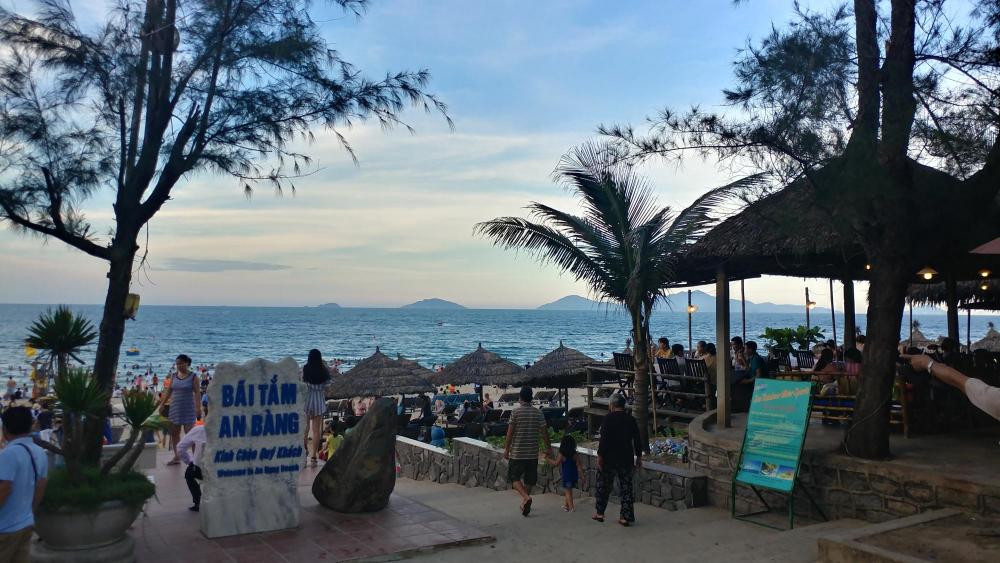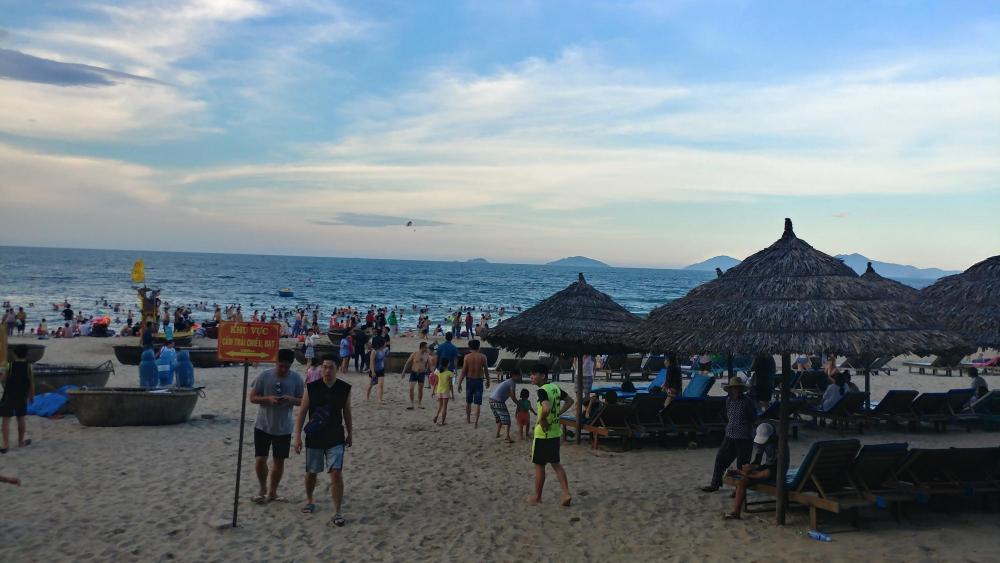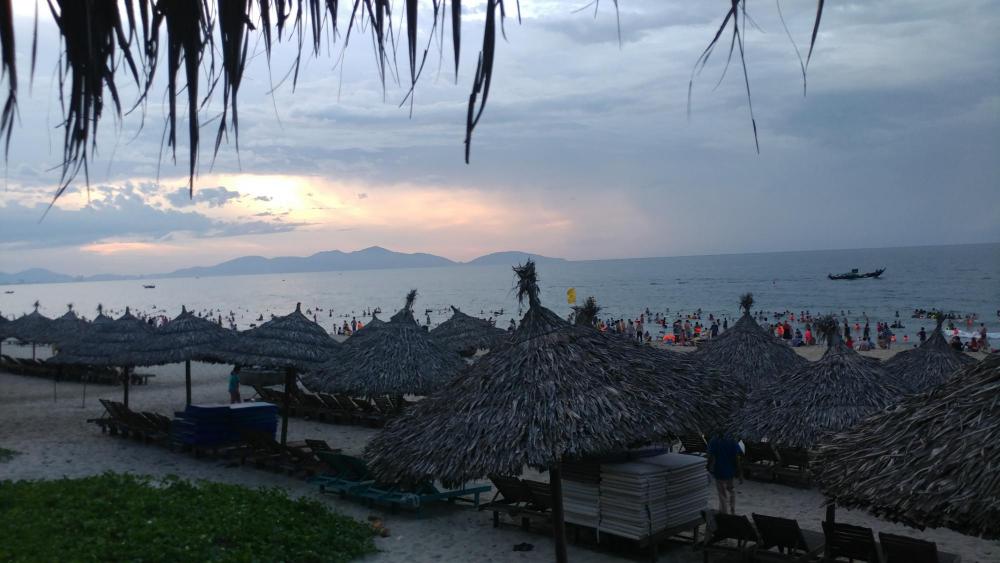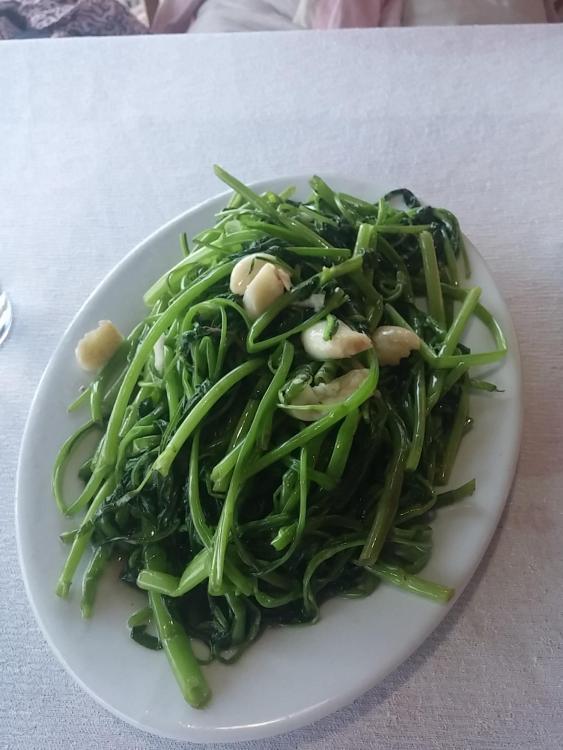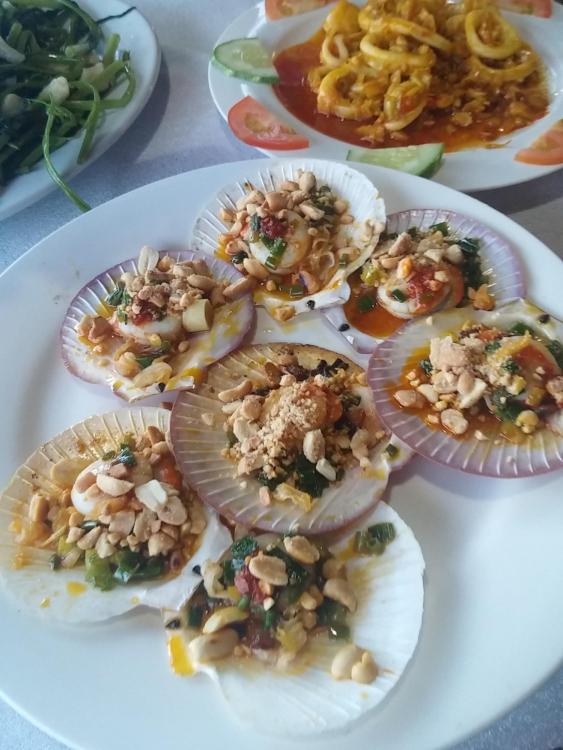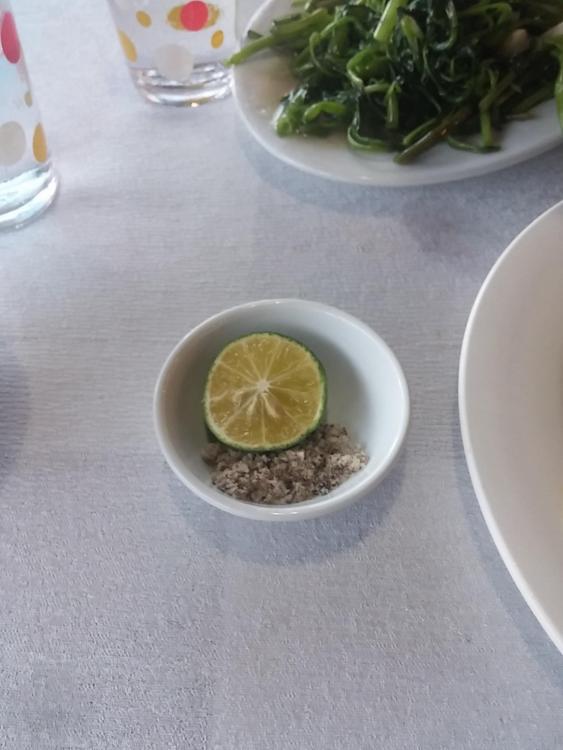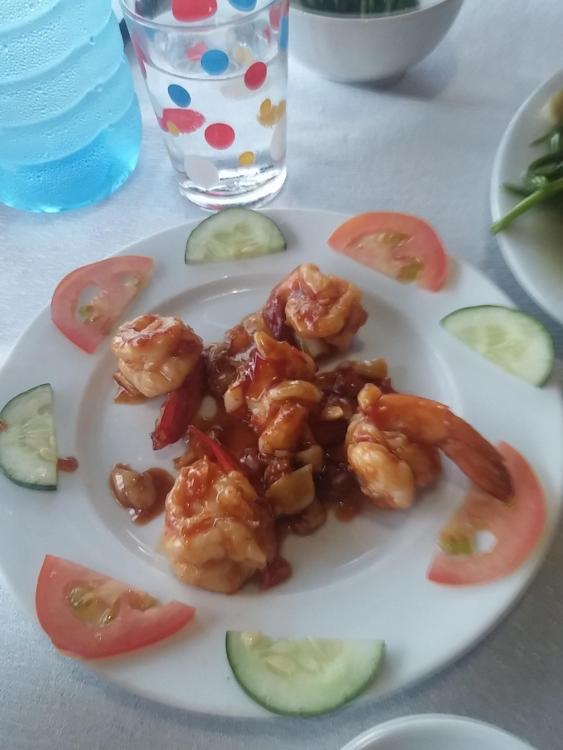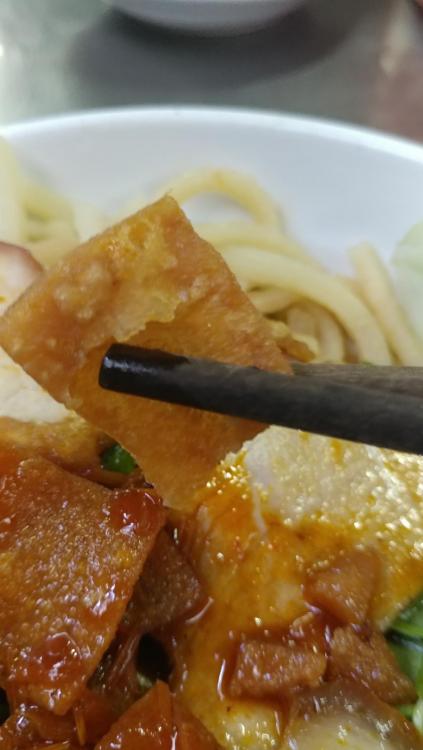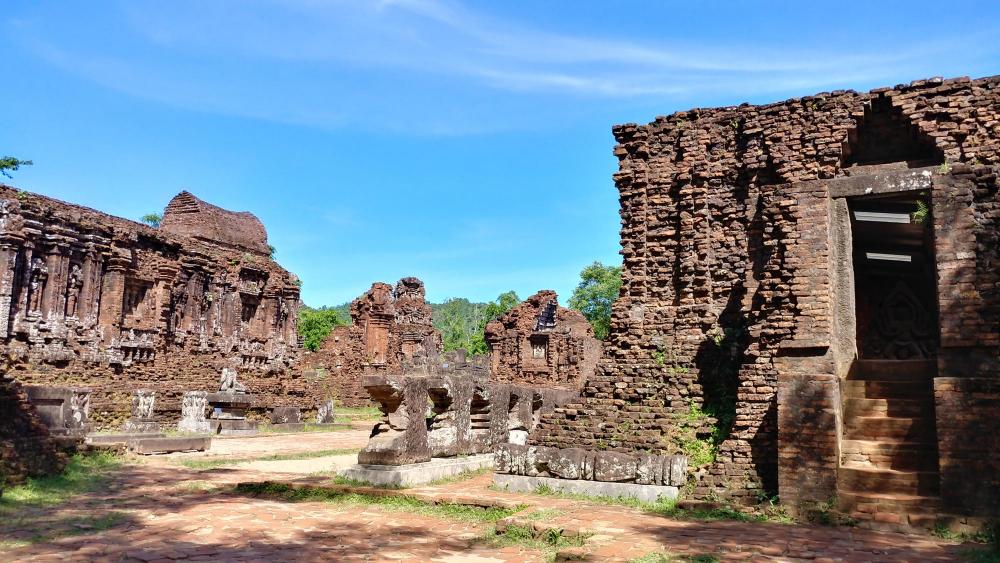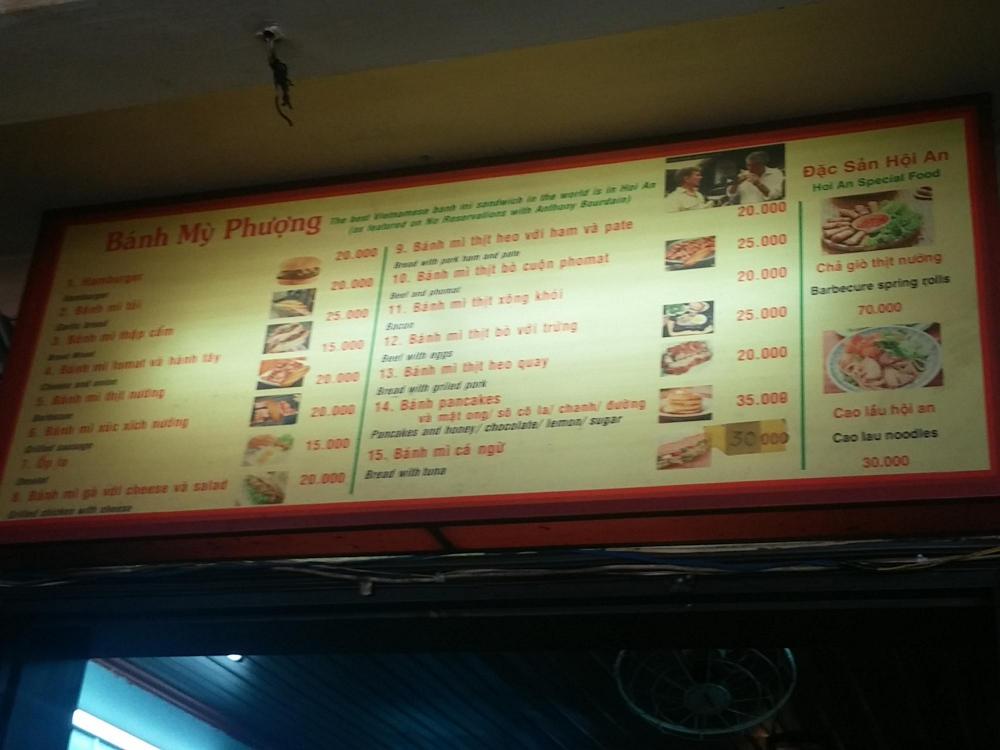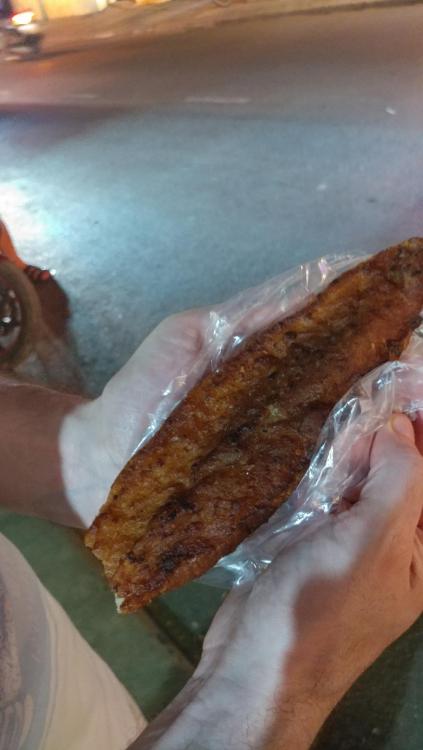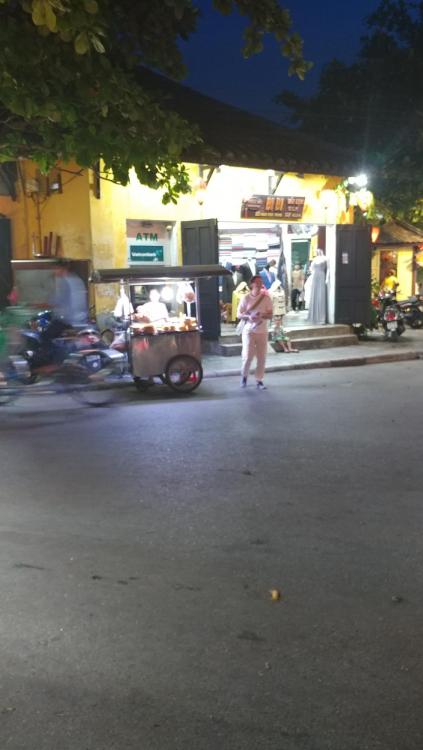
KennethT
participating member-
Posts
6,822 -
Joined
-
Last visited
Content Type
Profiles
Forums
Store
Help Articles
Everything posted by KennethT
-
Week in coastal Central Vietnam foodblog
KennethT replied to a topic in Elsewhere in Asia/Pacific: Dining
The next day, we woke early to do some touring outside of Hue - this is very common as most of the tourist sites here are outside the city. First, we took a dragon boat down the Perfume river for about a half hour.... Our boat.... On the river Our stop was the Thien Mu Pagoda: From here we took a taxi to see a couple of the Emperor's tombs.... there are several tombs in the area, but we only went to see 2 of them, since they are HUGE. The first one is the tomb of Minh Mang (ming mahng) - who ruled from 1820-1841. His tomb area is enormous - it's like a giant park with lakes, meandering streams, manicured grounds... very tranquil. These photos don't really do the place justice - it's like trying to photograph Boston Commons or something. The next tomb we visited was totally different in style. It was the tomb of Khai Dinh (hchai ding). This tomb is much smaller - and not really like a park, but is built into the side of a mountain and is all stone. It was supposed to be a combination of French and Vietnamese styles as this leader was highly influenced by the French. He is the one responsible for changing the Vietnamese written language from using Chinese characters to what is used today, in 1919, although the system currently used was devised by a French missionary hundreds of years before. After that, we returned to the hotel to cool down and relax a bit before heading back out to lunch. Since having breakfast so early (and my tapeworm was kicking in full force) we had a snack at the hotel: Some pork and shrimp goi cuon (summer rolls) and a lime juice (limeade). Interestingly, they served it with the nuoc cham, fish sauce based sauce rather than a peanut and hoisin based sauce that would have accompanied it in Saigon. -
Week in coastal Central Vietnam foodblog
KennethT replied to a topic in Elsewhere in Asia/Pacific: Dining
Geez... this whole "work" thing is really cutting into my posting time... Breakfast was again included in our hotel rate. They had a wide array of Western options, as well as a Vietnamese soup station making Bun Bo Hue (boon baw hway), of course, but also pho and I think they also made banh canh (buyng cuhng) which is another specialty of Central Vietnam, which I'll discuss in a second... Interestingly, the hotel's version of bun bo hue was quite good, even by comparison to the local options, and they gave out as much herbs as you'd like... As opposed to pho, bun bo hue uses round rice noodles, not flat, and there are pieces of beef as well as usually some kind of caseless sausage-y things - but more quenelle-like in texture. Some are made from beef/pork, others have shrimp or crab in them. Bun bo hue is very aromatic, mostly with notes of lemongrass and a slight shrimp paste flavor... some places had the shrimp more predominant than others. Typically served with it are limes (key limes), sliced chilis, lettuce, mint, thai basil (the mini kind was prevalent in Hue as well as Hoi An) and some spirulized thing which I'm not exactly sure what it is.. I didn't get a photo of it here, but it should show up later and I'll point it out. After breakfast, we went to see the major sight of Hue, the imperial citadel, which was the home of the Emperor until the 1800s when the French colonized VN. This has become the symbol of Hue. This is the main gate into the citadel: The entrance courtyard: Inside one of the halls: After seeing the citadel, it was time for lunch, so I wanted to go to a local place for banh canh. When we were in Saigon, on the excursion to see the Cu Chi tunnels, we stopped for lunch at a place that specialized in banh canh - I didn't realize it at the time, but banh canh is a specialty of the central part of Vietnam. We went here: Here's their menu to note the prices: This is basically saying that a "big bowl" of banh canh is 20,000VND - less than $1. This is the banh canh. Note how thick the noodles are - they have a very interesting texture. This place had these pork quenelles and a couple of shrimp, whereas the place near Saigon just had slices of boiled lean pork. The overriding flavor of banh canh is black pepper - there is even a dish of black pepper (doled out with a spoon, not a shaker) in the condiment tray in case you want more. Green onion is provided for greenery. After lunch, we went back to the hotel to relax in the A/C and get out of the heat, and then we enjoyed our free 45 minute massages, offered to us upon check in... How sweet is that? After we recovered, and layed around some more, we went for dinner - to a place that specialized in Bun Bo Hue... Some sidewalk shots walking around... I had to stop and pick up more mangosteen. These weren't as good as the ones I got in Hoi An, but were less expensive - a little less than $2 per kilo: The bun bo hue: This has a pork quenelle, some pieces of beef, and the yellow quenelle I think is made from crab. It's served with: Limes, chilis, lettuce, mint (peppermint again!) , and it looks like the spirulized thing on top would be some kind of dried shallot. The broth here was very similar to what we had at the hotel. Here's the place's sign: The name of the restaurant is Quan Ba Xuan - basically meaning Mrs. Suan's restaurant. ETA, in the middle of the sign, it says Chinh Hieu - which means they understand Chinese... I just noticed this now! -
Week in coastal Central Vietnam foodblog
KennethT replied to a topic in Elsewhere in Asia/Pacific: Dining
Hue is the original Imperial capital of Vietnam - it, like Hoi An, has quite a few dishes that are specific to the area, and like Hoi An, gets quite a few Vietnamese tourists coming to have the foods of the area in the area... Our first dinner in Hue was at this place... Tai Phu (tie foo), conveniently located just a couple of blocks from our hotel. It has expanded from its origins - the original restaurant and kitchen are here: They have since expanded to include more seating across the street: We sat in the "new" location - what's interesting, is that when you place your order with the waitress, she then yelled it across the street to the kitchen! Then, when ready, they brought your dishes across the street (through the traffic).... They're most known for nem lui (nuhm loo-ee) - it's basically some kind of fermented sausage, grilled on a stick, and they're awesome! Nem lui is served with this: This is a big plate of things you add to your thin, flexible rice paper (barely seen, on the very right side) - there's lettuce, mini thai basil, cilantro, diep ca (fish mint!), cucumber, slice of green mango, and most interestingly, slices of an unripe fig that only grows near Hue called Trai Va (chay vuh), plus the requisite pickles. This is then dipped into the murky brown sauce that is made from hoisin, shrimp paste, fermented beans, peanuts, garlic, shallots and who knows what else. The trai va is slightly sweet, and slightly bitter and astringent - it goes well with fatty foods. We also got banh khoai (buyng hch-oh-ay) - which is sort of like the banh xeo you saw earlier in Hoi An, but it's much crispier. Lastly, we also got Bun Mam (boon mem): This is thin rice noodles with lettuce, herbs, cucumber, bean sprouts, pickes, pork belly and fried shallots. You then spoon on the brown sauce served with the nem lui (and I added some chili paste as well)... that was an explosion of flavor... All of this was about $5, including two bottles of water. Getting back to the hotel, we were greeted with a gift on our pillow, two little sable cookies that were ridiculously buttery, and melted in your mouth: -
Week in coastal Central Vietnam foodblog
KennethT replied to a topic in Elsewhere in Asia/Pacific: Dining
Unfortunately, I only get one or two vacations per year, usually at the same times... there's the summer one, and then the week between Xmas and NYs... this past winter, we couldn't go anywhere, so when we saw the inexpensive fares for the summer, we jumped on them, heat be damned! -
Week in coastal Central Vietnam foodblog
KennethT replied to a topic in Elsewhere in Asia/Pacific: Dining
Back in the car, we continued on our way to Hue, going through the Hai Van pass... In the old days, this was the only way to go, but now, there is a faster road that goes in a tunnel through the mountain. But we preferred the scenic route: At the top of the pass, there is a string of restaurants and convenience stores. Our driver was sort of shuttling us into the restaurant all the way on the left side as you face it, and for a minute, I didn't understand why he was basically insisting we go to this one, without even looking at what the other ones offered... but I realized that the food was pretty much inconsequential... you go to that restaurant for this view: A quick shot of part of the "kitchen": Also on top of the pass is a US pillbox left over from the war, riddled with bullet holes... On the way back down the pass, there were more interesting views... Of all of these sightseeing pics, I've only posted a small fraction of what we took.. Next stop, Hue!!! -
Week in coastal Central Vietnam foodblog
KennethT replied to a topic in Elsewhere in Asia/Pacific: Dining
OK, so the next morning, we woke up early to leave Hoi An and make our way up to Hue (hwhay), stopping to do a little sightseeing on the way. Our first stop was to Danang, to see the Marble Mountains. The MM are these large limestone formations that rise up straight out of the ground, and the city was basically built around them. Each of the mountains is named for a different "element" - there's the fire mountain, air, etc... the biggest and most famous is the water mountain, which is one we're on. Each mountain has it's own pagoda... this is water mountain's: Once you go past the pagoda, there are steps leading up the mountain, to 4 different caves. There was quite a bit of climbing involved: After getting through the cave, and the climb (by the way, there was no indication before going in that there was any climbing involved, and the movement of people was only 1 way - so once you made it through a bit, there was no turning back!!!), there was more outdoor "climbing" up and down these stairs that were sort of carved into the rocks. Keep in mind that it is like 95 degrees and in full sun - so those rocks were really hot - sometimes, you needed to put your hand down to keep balance, and it felt like you could fry an egg on there!!! Here's inside another cave... By the time we were mostly through, we were soaked with sweat. "Luckily" there was a rest station where we could buy some only moderately expensive energy drinks - not nearly as inflated pricing as we saw at the Great Wall of China. -
Week in coastal Central Vietnam foodblog
KennethT replied to a topic in Elsewhere in Asia/Pacific: Dining
Sorry for the long lapse in posting, folks! @sartoricNo kudos necessary - we actually enjoy the long flight - I prefer them to a shorter flight like to California or to Europe (we're in NY so we're in between both of them) since we medicate ourselves and get a decent 6-8 hours of sleep (even sitting in coach), watch a few movies, and eat 2 meals and a snack in between. Also, I'm sure it depends on the airline - we've been using EVA quite a bit primarily because they have the best prices from NY to SE Asia (this trip cost us USD$1000 round trip, inclusive of all taxes and fees, which is a great deal - and cheaper than most flights to Europe nowadays!), but they are also quite comfortable with good service and decent food. -
Week in coastal Central Vietnam foodblog
KennethT replied to a topic in Elsewhere in Asia/Pacific: Dining
@rotutsYou're very welcome... sorry there's been nothing yet today, i've been very busy at work and haven't had much more time than a minute here and there.... we're about halfway through our visit... the next episode will talk about us leaving Hoi An and heading up to Hue, and the beauty that exists in between.... -
Week in coastal Central Vietnam foodblog
KennethT replied to a topic in Elsewhere in Asia/Pacific: Dining
Many years ago, we were in Hanoi in mid-March... cool and drizzly the entire time we were there - but totally charming. One day, we will go back. Then last December/Jan. we were in Saigon - I did a foodblog about that trip - that was amazing. We are already talking about a trip to the south - the Mekong area which we have not yet seen - but that would have to be in Dec/Jan because it would be too rainy during our summer vacation time. ETA - we didn't even see the Dalat wine - we would have love to have tried it! -
Week in coastal Central Vietnam foodblog
KennethT replied to a topic in Elsewhere in Asia/Pacific: Dining
@Nyleve BaarThat would have been a great time to go there - a lot cooler than what we saw, and statistically not much rain either. -
Week in coastal Central Vietnam foodblog
KennethT replied to a topic in Elsewhere in Asia/Pacific: Dining
It was crazy... For most of the time we were there, there was a daily high of about 100F with 95% humidity. I think the heat index was about 120F or something like that. The early mornings and evenings were cooler - about 85F. I don't think it went below 80F for the first 7 days or so. Then there was a big thunderstorm (pictured way up in the teaser section) and the heat broke - it became a high in the upper 80s to low 90s with only moderately high humidity (it is tropical). -
Week in coastal Central Vietnam foodblog
KennethT replied to a topic in Elsewhere in Asia/Pacific: Dining
For dinner, we took a short walk over a bridge to Cam Nam island, which is interesting just because they make some dishes on that island that are not available anywhere else in Hoi An. The bridge is pretty narrow, and the "sidewalk" is ridiculously narrow... We took a picture on the way back, when it wasn't that crowded, but on the way there, it was rush hour, so imagine the bridge elbow to elbow with motorbike and car/truck traffic in both directions. it was pretty harrowing - my wife was gripping the stone railing for dear life! Once you cross the bridge, and walk down the road to its end, there are a bunch of restaurants one after the other that all basically serve the same dishes.... We just picked one that looked the busiest. One dish to go here for is: This is banh dap (buymg dap (sounds sort of like tap)). There is a crispy rice paper on both sides of a piece of wet rice paper that you smash to break into pieces, then dip in the murky brown mam tom sauce, which is basically shrimp paste in water with lime juice, some sugar, and garlic - very shrimpy and very addictive (if you like pungent, fermented shrimp). The chili paste in the middle is for you to add to your dish of sauce if you want it spicier. The bottom two plates are Hen Tron (hen chon), which is basically a big plate of minced clams. Very clammy - topped with sliced onion, peanuts and sprigs of Rau Ram (rrggrrow rrggrram). You eat this with the piece of grilled rice paper, banh trang (buymg chuymg), which is crispy. Our waitress also convinced us to get a plate of chicken rice (co'm ga): The chicken rice came with soup - and the waitress told us that you're supposed to put a spoonful of soup on the portion of rice you're about to eat. Mind you, she did all of this by miming, and pointing to a picture of the co'm ga and not leaving until we ordered it. I'm glad she did though, because there's only so much minced clams a person can eat (even if they like clams) so it was good to get another dish that was a little more substantial. This whole meal cost about $3. What's also nice about this place is that it came with this view from our table: Walking out, we saw this scene: Then walking through the cute little village again before going back over the bridge: Then a short walk along the river back to our hotel... a scene along the way: -
Week in coastal Central Vietnam foodblog
KennethT replied to a topic in Elsewhere in Asia/Pacific: Dining
@SmithyThese are the typical limes found in SE Asia (I think we discussed this in the Singapore foodblog) - they are the true limes, similar (if not even the same) to key limes. What we call Persian limes, or Bearss seedless limes, are not a true lime but a cross between a key lime and a lemon. There is a picture of the lime, unsqueezed, upthread in the section about the restaurant on the beach. They commonly squeeze this lime onto salt/chili or salt/pepper to make a paste for dipping meat or seafood (or sometimes fruit). These limes taste much like a key lime - I can't compare direclty, because I've never had them side by side, but they seem the same to me - they have thinner skins than a Bearss lime - sometimes the lime is cut into small pieces, skin and all, and eaten like in the dish Mieng Kum in northern Thailand. This lime also has seeds. -
They sometimes use shade cloth when growing lettuce in greenhouses too. Very effective - lettuce doesn't need or like full sun.
-
Week in coastal Central Vietnam foodblog
KennethT replied to a topic in Elsewhere in Asia/Pacific: Dining
Seriously, maybe they're using a strain of heat resistant lettuce? -
Week in coastal Central Vietnam foodblog
KennethT replied to a topic in Elsewhere in Asia/Pacific: Dining
Plus you basically need to spray it ALL THE TIME. In some of the plots where nothing was growing, there were puddles!!! -
Week in coastal Central Vietnam foodblog
KennethT replied to a topic in Elsewhere in Asia/Pacific: Dining
I know!! I was shocked to see lettuce growing so well in full sun in 100degF with 95% humidity. Maybe because it was constantly being sprayed with magical algae water? -
Week in coastal Central Vietnam foodblog
KennethT replied to a topic in Elsewhere in Asia/Pacific: Dining
After viewing the garden, we went to one of the restaurants that gets all of their produce from the village - they also have a cooking school: It had a very peaceful setting with an open air, thatched roof. There was a family of British people, 2 adults and 2 small kids - maybe 6 and 8 years old? - who were taking a cooking class, which was done at one end of the dining room. It was interesting to see little kids dropping stuff to be deep fried into a small wok precariously balanced on a small propane burner. No one was injured in the making of their lunch that day. I didn't take a photo of it - I thought that might be rude... but it was a cute scene. Lime juice - by the time we got there, we were ridiculously hot and sweaty from sauntering around the vegetable village - even with our sun umbrellas! So refreshing... Banh Xeo, served with rice papers, lettuce, some kind of sprout, and spearmint (no peppermint this time). Not nearly as greasy as the one at BaLeWell - very tasty. It came with a fish sauce with lots of smashed garlic. Here's an action shot just prior to consumption: Cha Gio spring rolls - not greasy at all ... very good. Bo La Lot (baw lah lut) - beef covered with lemongrass and la lot leaves (betel leaves) and grilled on a banana leaf. This was awesome. The beef was tender and flavorful, and the betel leaves definitely impart a unique flavor that is hard for me to describe. And the lemongrass was actually tender - which was mindboggling since when I use lemongrass at home, the desiccated stalks, even when cooked have the texture of sawdust. more Rau muong stir fried with garlic Off the back end of the dining room was the restroom, and next to it, a small plot of farm land and drying racks for what looked like sweet potato crackers. -
Week in coastal Central Vietnam foodblog
KennethT replied to a topic in Elsewhere in Asia/Pacific: Dining
The next day, we visited the Tra Que (chah gweh) Vegetable Village in the morning. The village was established about 300 years ago, and supposedly has the best tasting herbs and vegetables because they use no fertilizers or pesticides, but the water they use has a specific kind of algae that makes everything taste so good. All the produce is used in Hoi An by most of the local restaurants. There is supposedly a whole list of plants that they grow, but when we were there, I only saw a few varieties of things... We saw lettuce, a lot of mint (peppermint!), what looked like green onion, cilantro, morning glory, thai basil with small leaves and a few other odds and ends here and there. I was looking for that weedy herb that I saw in many dishes that I liked, but never saw it there. Lots of the farmers supplement their income by also having a cooking school for tourists, and part of the experience is to "practice being a farmer" which I jokingly translated into temporary free labor... well, better than free, they pay you to weed your garden!! Supposedly, there is a fee to view the village, but we couldn't find a ticket booth and when we asked a person overseeing some "temporary farmers", she said that a guy walks around to issue tickets, and if you see him, run the other way! To be honest, I didn't think the herbs or veggies that I had (that all supposedly came from the village) tasted much different than normal - or had any more flavor than what I grow at home. In fact, I thought the hydroponic herbs I grew (comparing apples to apples) were more flavorful... but in any case, here's some photos of it. Green onion? Lettuce Fish mint down at the bottom!!! Run!!!! A papaya tree here and there A reservoir containing the magical algae water... there were several of these scattered around, plumbed into pumps that fed the sprinkler irrigation system. Some peppermint down at the bottom. -
Week in coastal Central Vietnam foodblog
KennethT replied to a topic in Elsewhere in Asia/Pacific: Dining
For dinner that night, we decided to go to a seafood restaurant on the local beach. There are two beaches in Hoi An, Cua Dai (koo-uh die) beach, which is the more touristed one as it's closer to town, and An Bang (un bumg) beach which was more local. We're not really beach people, but I had heard that there are some good seafood restaurants at An Bang beach.... plus, it was beautiful to hang out and watch the sunset while having dinner on the beach. There are many restaurants in a strip behind the beach, which all looked like they had the same things (vietnamese seafood, then hamburgers and pizza!), with all of the places looking like they had their own tanks full of live fish and seafood waiting for orders. This is the view from our table: Rau Muong (rrggrrow moo-umg) - stir fried morning glory (water spinach) with garlic. Yum! Squid with lemongrass and chili - perfectly cooked with a nice lemongrass flavor, not too spicy. Grilled scallops with peanuts and green onion. So good, and I'm not usually a fan of scallops! I think the orange stuff you see in there is roe or something like that. dish of salt/pepper to make a paste with the lime juice for dipping grilled foods. shrimp with tamarind sauce This was not served with banh mi, as would have in Saigon, and I don't think we even saw any rice or anthing like that - but we didn't really need it since we had our cao lau snack just a couple hours before... -
Week in coastal Central Vietnam foodblog
KennethT replied to a topic in Elsewhere in Asia/Pacific: Dining
After lunch, being thoroughly sweaty and tired after the morning sightseeing, we went back to the hotel to relax in the A/C and get some pool time. Interestingly, the pool water felt like bath water, it was so warm! But, it was nice to relax... after the pool time, we walked around the old town some more (which really isn't that big - it's maybe 8 blocks by 3 blocks), and then ventured off into a local neighborhood away from the old town to find a really good, local Cao lau, since the one on the first night was rather disappointing, for a mid-afternoon snack to satisfy my tape worm. When we got to the place that I had been recommended, we found that it was closed! But, two doors down was another Cao lau place that was busy (we got the last table) and looked good. This one was awesome... really really tasty. The noodles had a very intersting texture - firm but soft, and the outside was rough. The pork crackling was incredible - light, crispy, not greasy at all.... fantastic. The greenery consisted of lettuce, that weedy herb that I saw from time to time (that I now wish I brought back) and mint. Oddly enough, there was a lot of mint in things all over central VN - but not the mint that we had in Saigon - it tasted like peppermint! After a while, we found that everything reminded us of Wintergreen chewing gum... Here are the ladies out front making the dish, and making a to-go order for someone on a motorbike: -
Week in coastal Central Vietnam foodblog
KennethT replied to a topic in Elsewhere in Asia/Pacific: Dining
So the next day, we woke up really early to go out to the My So'n (meh-ee sun) Champa ruins, originally constructed between the 4th and 14 centuries. It's probably about an hour and a half drive from Hoi An, and we left really early because we wanted to get there before the tour buses did. Some people said not to bother going because the Champa ruins at Angkor Wat in Cambodia or Borobodur in Indonesia are much more stunning, but considering we haven't been to either of those yet, My Son here we come! Plus, we had the time and we felt it would be ridiculous to be so close and to not see it. It was sad to see that so much of the site was devastated by bombing during the US war. Many guidebooks say to keep to the well-trod paths because there could be unexploded land mines in the area as well - although, guides that we met there said that over many years, they (along with help from other countries) have swept the area and they think they have removed it all. Luckily, since we got there pretty early, there were few other tourists there, and we had a beautiful (if not ridiculously hot, even in the morning!) day for it. We got back to Hoi An just around lunchtime, so rather than take us back to the hotel, I asked the taxi driver to drop us off here: This is Banh Mi Phu'o'ng (buyng mee foo-uhm) - a banh mi sandwich place made extremely famous by St. Bourdain on his Hoi An show. On that show, he proclaimed this place to make the "best banh mi in Vietnam" which is quite a claim - I'm sure he's tasted all the other ones first so as to properly make that claim!!! But, in his honor, they have put his photo (a frame grab from the episode) all over the place there. To be honest, I thought the banh mi was very good, but certainly not the "best in Vietnam". Personally, both banh mi I got in Saigon, but especially that grilled meatball banh mi I got from a cart (see the Saigon post) was more enjoyable to me, but I'm not St. Bourdain, so what do I know. Also, just like the rest of the bread we had in central VN, we thought the texture of the bread wasn't as good as the multitude of ones we had in Saigon - the outside not as crispy, the inside not as light and tender. Don't get me wrong, it was still very good, but not mind-blowing like the ones we've had previously. The menu... they also had tables inside, and a multi-page menu (one item per page) showing all their banh mi, plus all the other dishes they made - they made a bunch of the "hits" of Hoi An like Cao lau, spring rolls, etc. Also note the prices - most of their banh mi cost less than $1 - we got 2 of the specials, which included the pate and several different cuts of pork. The inside consisted of pork pate, some kind of ham, pork belly, and some lean pork meat, plus the mayonnaise, lettuce, cucumber, pickles, and I got some chili in mine. -
Week in coastal Central Vietnam foodblog
KennethT replied to a topic in Elsewhere in Asia/Pacific: Dining
@SmithyThere is no way I'll try to reproduce the "pork toasts" at home! My doctor would have a fit! Funnily enough though, my wife and I joked that I had a tape worm on this trip, as I'd find myself starving every few hours. I don't know if it was because the portions are relatively small (many of the locals we saw in central VN were very thin - even more so than the normally slender SE Asian person we've encountered on our various travels - even the stray cats and rats around looked skinny!) or the heat or all the walking around, but I definitely think I lost weight on this trip! -
Week in coastal Central Vietnam foodblog
KennethT replied to a topic in Elsewhere in Asia/Pacific: Dining
How could I forget this? While walking back to our hotel from BaLeWell, I stumbled on a vendor selling this: This is Banh Mi Cha Chien (buyng mee sha shee-en) - or fried pork bread. A mixture of ground pork, garlic, salt and sugar are spread on the bread and then the whole thing is deep fried. I had read about this in my research of Hoi An, and I saw a vendor selling fried stuff from a cart across the street. The street was busy at that time, and as in much of Vietnam, there are no traffic lights, crosswalks, or anything to break the flow of traffic - so crossing the street is always fun... but my wife was too nervous to cross with me, so she stayed across the street and waited for me to come back. Unfortunately, the bread in Central Vietnam (or what I had of it) wasn't nearly as light and crisp as what was in Saigon, and the resulting fried bread was a little chewy and tough, and slightly greasy - so I didn't eat that much of it - but found once eating it, it was a little addictive for some odd reason. But it was fun to try it.... and cheap - like $0.40 or something like that. This is me looking to cross the street after making my purchase. You might notice in the background that there is a tailor shop (there's a dress on a mannequin by the steps). Hoi An is known for its tailors - there are literally 5 on every street, each of them hawking you as you walk by (and each have their own incense burning on the sidewalk or at the entrance to their shop!) The most often heard phrase in Hoi An is "hello, you want to buy something?" It was cute in the beginning, but it soon wore on me - and if you tried to be nice by making eye contact and saying "no, thank you" in English or Vietnamese, mind you, that would just encourage them more - so we just learned to not look at them and keep walking. But, no one is too aggressive, and they all hawk with a smile, so it's really not that bad... and they don't take offense if you just keep on walking. Also, once you get out of the most heavily touristed areas, you don't see that happen anymore. -
Week in coastal Central Vietnam foodblog
KennethT replied to a topic in Elsewhere in Asia/Pacific: Dining
Yes, in Hoi An, the smell of incense is everywhere... not always super-strong, but ever-present. Less so in Hue, but it was still there here and there. I can't imagine a whole cone of incense in a bedroom! This actually reminds me of the 'old days' in NYC - back in the '80s and early '90s when taxi drivers would commonly burn 2-3 sticks of incense at once on their dashboard!







